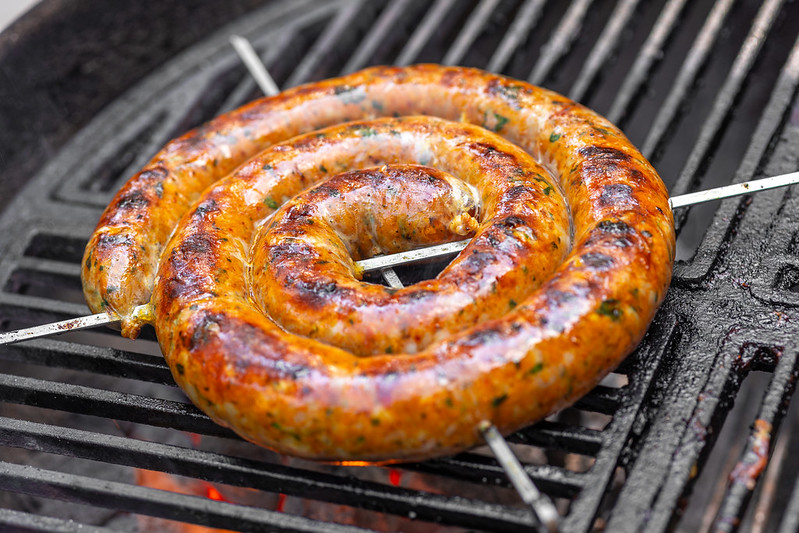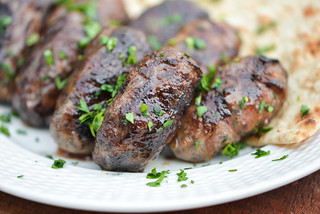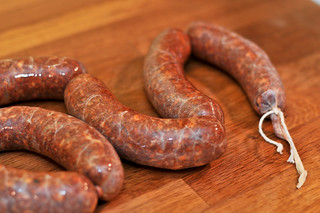Sai Ua (Northern Thai Sausage)
A majority of my time eating when I visited Chang Mai was spent in markets. That's where I first encountered nam prik noom, had the most delicious curry puffs ever (I went back every day and got more of those), and learned about the incredibly delicious sai ua, a sausage of Northern Thailand. Since I always produce a fairly large quantity every time I make sausage, I've been waiting for the right timing and crowd to finally take a crack at making sai ua myself, and things aligned when I decided to do a Thai-themed Meatwave last summer.
To be honest, sai ua wasn't my first choice sausage to make—I originally had planned to use a panang curry paste to make a panang sausage. After some consideration though I opted to use the panang paste on chicken wings and decided that I should really try out the traditional links first before venturing into new territory. The two concepts aren't that far apart though because sai ua's primary seasoning is a red curry paste, albeit the quantities of the ingredients differ from a standard red curry paste.
So my first step was to assemble the paste, which I always like to do in my mortar and pestle, although you can choose to use a food processor, or even the fine die of a meat grinder, to make quicker work of it. However, I've been told nothing quite matches the texture and flavor produced from the mortar and pestle and I find it almost meditative as I pound down each ingredient, one-by-one, until I have a cohesive and very aromatic paste developed.
After I made the paste, I cubed up both pork shoulder and pork fatback and set them on sheet pan that I placed in the freezer until they both firmed up. For the best sausages, all ingredients need to ice cold and more-or-less stay that way throughout the entire process, so chilling the meat really helps get things started on the right foot.
Sai ua is a coarsely ground sausage, and having everything ice cold is even more important in this context because the right texture requires both the fat and meat to remain separated. Since the coarse texture is a desired trait here, I also used my large cutting die and only sent the meat through the grinder a single time.
After the meat was all ground, I combined it with the curry paste along with roughly chopped cilantro, finely sliced makrut lime leaves, and salt and gave the entire thing a whirl in the KitchenAid. I let that mix on low speed until everything looked evenly distributed and then stopped to avoid the meat from breaking down too much—for smooth textured emulsified sausages, the meat mixture gets spun for a lot longer.
Since there's no going back, or at least I never want to go back, after the meat is stuffed into casings, I always break off a small bit of sausage at this point and fry it up for a taste test. Usually I find I may need a tad more seasoning here and there to get it just right, but in the case of this sai ua, the sausage was so intense tasting that I worried I may have gone a bit too overboard on the curry paste. The fix for this would be to add more meat, but that wasn't really an option at the time. so I decided to go forth with stuffing and hope either the flavor would mellow a bit as it rests, or may not taste so over the top when eaten with some accompaniments, like cabbage.
One nice thing about sai ua is that its left as one big long link. In my early days of sausage making, tying links was always a little stressful because I would sometimes break the links, and stuffing them over again can be pain. That really isn't an issue for me anymore, but still, just rolling the sausage into a spiral and being done felt nice and easy. The only additional steps I did was pop any air bubbles and secure the massive link together by running two skewers through the center perpendicular to each other.
To cook this, I utilized a medium-hot fire and grilled it over direct heat. I flipped and moved the sai ua around from time to time to keep an eye on how the exterior was browning, and I used an instant read thermometer to ensure I wasn't overcooking it. I pulled the sausage off the grill once it hit north of 155°F in the center, by which time it was nicely browned on both sides.
To serve, I sliced the giant link into bite-sized pieces on a bias and put some herbs and cabbage out for anyone who might like those alongside. I'm not sure if my initial impression of that test link was wrong, or if the seasoning did mellow out a bit after resting and grilling, but the final sausage tasted pretty spot on. It was still incredibly flavorful with strong tastes of lemongrass, galangal, and garlic, with chilies giving it a fair amount of heat. The cilantro was noticeable, although struggled to amp up freshness in such a heavy seasoning, but the lime leaves really sealed the deal for me with their very distinct aroma and flavor. I enjoyed eating this as-is, like I had done in the market in Chang Mai, but I still have one additional link of sai ua left that I'm trying to think of some creative use for and am open to suggestions. All I know for sure is that the day when I grill up another one of these is going to be a very good day.












